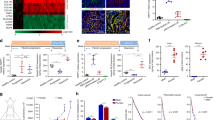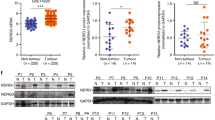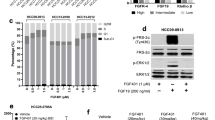Abstract
Hepatocyte growth factor (HGF) is involved in malignant behavior of cancer cells by enhancing invasion and metastasis. We earlier found that NK4, a four-kringle fragment of HGF, functions as both an HGF antagonist and an angiogenesis inhibitor. We have now carried out studies to determine if hydrodynamics-based delivery and expression of the NK4 gene would inhibit liver metastasis and invasive growth of colon carcinoma cells in mice. When the naked plasmid for NK4 was introduced into mice by hydrodynamics-based gene delivery, a high level of expression of NK4 was predominant in the liver. After intrasplenic inoculation of MC-38 murine colon carcinoma cells, the cells formed numerous metastatic nodules in the liver and showed invasive growth behavior. On the other hand, when mice were given the NK4 plasmid, hepatic gene expression of NK4 inhibited the liver metastasis and subsequent growth associated with a decrease in microvessel density. Likewise, intrahepatic invasion of cancer cells was inhibited by NK4 gene expression, and this anti-invasive effect was associated with in situ inhibition of c-Met receptor tyrosine phosphorylation. Moreover, NK4 gene expression prolonged survival of these mice. Taken together with the knowledge that the majority of deaths from colon cancer are due to liver metastasis, the potential therapeutic use of hepatic gene expression of NK4 for metastatic colon cancer treatment can be given consideration.
This is a preview of subscription content, access via your institution
Access options
Subscribe to this journal
Receive 12 print issues and online access
$259.00 per year
only $21.58 per issue
Buy this article
- Purchase on Springer Link
- Instant access to full article PDF
Prices may be subject to local taxes which are calculated during checkout









Similar content being viewed by others
References
Brand MI, Saclarides TJ, Dobson HD, et al. Liver resection for colorectal cancer: liver metastases in the aged. Am Surg. 2000;66:412–416.
Stangl R, Altendorf-Hofmann A, Charnley RM, et al. Factors influencing the natural history of colorectal liver metastases. Lancet. 1994;343:1405–1410.
Sprangers MAG . Quality-of-life assessment in colorectal cancer patients: evaluation of cancer therapies. Semin Oncol. 1999;26:691–696.
Nakamura T, Nawa K, Ichihara A . Partial purification and characterization of hepatocyte growth factor from serum of hepatectomized rats. Biochem Biophys Res Commun. 1984;122:1450–1459.
Nakamura T, Nishizawa T, Hagiya M, et al. Molecular cloning and expression of human hepatocyte growth factor. Nature. 1989;342:440–443.
Jiang WG, Hiscox S, Matsumoto K, et al. Hepatocyte growth factor/scatter factor: its molecular, cellular and clinical implication in cancer. Crit Rev Oncol Hematol. 1999;29:209–248.
Furge KA, Zhang YW, Vande Woude GF . Met receptor tyrosine kinase: enhanced signaling through adapter proteins. Oncogene. 2000;19:5582–5589.
Matsumoto K, Nakamura T . NK4 (HGF-antagonist/angiogenesis inhibitor) in cancer biology and therapeutics. Cancer Sci. 2003;94:321–327.
Jiang WG, Hiscox S, Singharo SK, et al. Induction of tyrosine phosphorylation and translocation of ezrin by hepatocyte growth factor (HGF/SF). Biochem Biophys Res Commun. 1995;217:1062–1069.
Uchiyama A, Essner R, Doi F, et al. Interleukin-4 inhibits hepatocyte growth factor-induced invasion and migration of colon carcinomas. J Cell Biochem. 1996;62:443–453.
Empereur S, Djelloul S, Di Gioia Y, et al. Progression of familial adenomatous polyposis (FAP) colonic cells after transfer of the src or polyoma middle T oncogene: cooperation between src and HGF/SF in invasion. Br J Cancer. 1997;75:241–250.
Hiscox S, Hallett MB, Puntis MC, et al. Expression of the HGF/SF receptor, c-met, and its ligand in human colorectal cancers. Cancer Invest. 1997;15:513–521.
Di Renzo MF, Olivero M, Giacomini A, et al. Overexpression and amplification of the Met/HGF receptor gene during the progression of colorectal cancer. Clin Cancer Res. 1995;1:147–154.
Date K, Matsumoto K, Shimura H, et al. HGF/NK4 is a specific antagonist for pleiotrophic actions of hepatocyte growth factor. FEBS Lett. 1997;420:1–6.
Date K, Matsumoto K, Kuba K, et al. Inhibition of tumor growth and invasion by a four-kringle antagonist (HGF/NK4) for hepatocyte growth factor. Oncogene. 1998;17:3045–3054.
Parr C, Hiscox S, Nakamura T, et al. NK4, a new HGF/SF variant, is an antagonist to the influence of HGF/SF on the motility and invasion of colon cancer cells. Int J Cancer. 2000;85:563–570.
Kuba K, Matsumoto K, Date K, et al. HGF/NK4, a four-kringle antagonist of hepatocyte growth factor, is an angiogenesis inhibitor that suppresses tumor growth and metastasis in mice. Cancer Res. 2000;60:6737–6743.
Folkman J . Angiogenesis in cancer, vascular, rheumatoid and other disease. Nat Med. 1995;1:27–31.
Hanahan D, Folkman J . Patterns and emerging mechanisms of the angiogenic switch during tumorigenesis. Cell. 1996;86:353–364.
Liu F, Song YK, Liu D . Hydrodynamics-based transfection in animals by systemic administration of plasmid DNA. Gene Therapy. 1999;6:1258–1266.
Yang J, Dai C, Liu Y . Systemic administration of naked plasmid encoding hepatocyte growth factor ameliorates chronic renal fibrosis in mice. Gene Therapy. 2001;8:1470–1479.
Jiang J, Yamato E, Miyazaki J . Intravenous delivery of naked plasmid DNA for in vivo cytokine expression. Biochem Biophys Res Commun. 2001;289:1088–1092.
Seki T, Ihara I, Sugimura A, et al. Isolation and expression of cDNA for different forms of hepatocyte growth factor from human leukocyte. Biochem Biophys Res Commun. 1990;172:321–327.
Niwa H, Yamamura K, Miyazaki J . Efficient selection for high-expression transfectants with a novel eukaryotic vector. Gene. 1991;108:193–200.
Tomioka D, Maehara N, Kuba K, et al. Inhibition of growth invasion, and metastasis of human pancreatic carcinoma cells by NK4 in an orthotopic mouse model. Cancer Res. 2001;61:7518–7524.
Noji S, Tashiro K, Koyama E, et al. Expression of hepatocyte growth factor gene in endothelial and Kupffer cells of damaged rat livers, as revealed by in situ hybridization. Biochem Biophys Res Commun. 1990;173:42–47.
Kuba K, Matsumoto K, Ohnish K, et al. Kringle 1–4 of hepatocyte growth factor inhibits proliferation and migration of human microvascular endothelial cells. Biochem Biophys Res Commun. 2000;279:846–852.
Maemondo M, Narumi K, Saijo Y, et al. Targeting angiogenesis and HGF function using an adenoviral vector expressing the HGF antagonist NK4 for cancer therapy. Mol Ther. 2002;5:177–185.
Hirao S, Yamada Y, Koyama F, et al. Tumor suppression effect using NK4, a molecule acting as an antagonist of HGF, on human gastric carcinomas. Cancer Gene Ther. 2002;9:700–707.
Saimura M, Nagai E, Mizumoto K, et al. Intraperitoneal injection of adenovirus-mediated NK4 gene suppresses peritoneal dissemination of pancreatic cancer cell line AsPC-1 in nude mice. Cancer Gene Ther. 2002;9:799–806.
Folkman J . Angiogenesis research: from laboratory to clinic. Forum (Genova). 1999;9 (Suppl. 3):59–62.
Young SD, Marshall RS, Hill RP . Hypoxia induces DNA overreplication and enhances metastatic potential of murine tumor cells. Proc Natl Acad Sci USA. 1988;85:9533–9537.
Cairns RA, Kalliomaki T, Hill RP . Acute (cyclic) hypoxia enhances spontaneous metastasis of KHT murine tumors. Cancer Res. 2001;61:8903–8908.
Rofstad EK, Rasmussen H, Galappathi K, et al. Hypoxia promotes lymph node metastasis in human melanoma xenografts by up-regulating the urokinase-type plasminogen activator receptor. Cancer Res. 2002;62:1847–1853.
Höckel M, Schlenger K, Aral B, et al. Association between tumor hypoxia and malignant progression in advanced cancer of the uterine cervix. Cancer Res. 1996;56:4509–4515.
Brizel DM, Scully SP, Harreison JM, et al. Tumor oxygenation predicts for the likelihood of distant metastases in human soft tissue sarcoma. Cancer Res. 1996;56:941–943.
Sundfor K, Lyng H, Rofstad EK . Tumor hypoxia and vascular density as predictors of metastasis in squamous cell carcinoma of the uterine cervix. Br J Cancer. 1998;78:822–827.
Blagosklonny MV . Hypoxia-inducible factor: Achilles’ heel of antiangiogenic cancer therapy. Int J Oncol. 2001;19:257–262.
Pennacchietti S, Michieli P, Galluzzo M, et al. Hypoxia promotes invasive growth by transcriptional activation of the met protooncogene. Cancer Cell. 2003;3:347–361.
Acknowledgements
This work was supported by Grants-in-Aid for Scientific Research from the Ministry of Education, Technology, Sports and Culture of Japan. We thank Dr K Kuba for technical assistance with this research and M Ohara (Fukuoka, Japan) for language assistance and helpful comments on this paper.
Author information
Authors and Affiliations
Corresponding author
Rights and permissions
About this article
Cite this article
Wen, J., Matsumoto, K., Taniura, N. et al. Hepatic gene expression of NK4, an HGF-antagonist/angiogenesis inhibitor, suppresses liver metastasis and invasive growth of colon cancer in mice. Cancer Gene Ther 11, 419–430 (2004). https://doi.org/10.1038/sj.cgt.7700705
Received:
Published:
Issue Date:
DOI: https://doi.org/10.1038/sj.cgt.7700705
Keywords
This article is cited by
-
Drug repurposing screening identifies bortezomib and panobinostat as drugs targeting cancer associated fibroblasts (CAFs) by synergistic induction of apoptosis
Investigational New Drugs (2018)
-
Cancer-associated-fibroblasts and tumour cells: a diabolic liaison driving cancer progression
Cancer and Metastasis Reviews (2012)
-
Prognostic value of tumor growth factor levels during chemotherapy in patients with metastatic colorectal cancer
Medical Oncology (2012)
-
Hydrodynamic Gene Delivery and Its Applications in Pharmaceutical Research
Pharmaceutical Research (2011)



